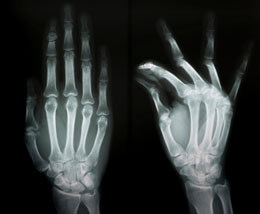Impacted fracture is a type of fracture in which one of the broken fragments of the bone wedges into another. Read on to know more..

Calcium phosphate renders the strength and hardness to the bones. Large amounts of calcium phosphates are deposited in the bones during childhood and puberty. This increasing amount of mineral salts increases the bones density. By the time a person reaches 30 years of age, his bones have attained a maximum density. Bones are tough structures, but certain impacts can cause fractures, which lead to breaking or cracking of the bones. In impacted fractures, the separated pieces of bones wedge into other bones.
What is Impacted Fracture
Although bones are very hard and can tolerate most powerful impacts, certain traumatic injuries may cause cracking or breaking of the bones. Bending or twisting of bones at an awkward angle or a collision with a harder substance may lead to cracking or breaking of the bones. Injuries resulting out of fall or collisions are mostly responsible for bone fractures. Depending upon the degree of fracture and extent of damage to other body parts, fractures are classified into different types of bone fractures. Sometimes, a single serious injury may cause the bone to break into several fragments. This is called comminuted impacted fracture. When these broken fragments are driven into other broken bone fragments, then it leads to impacted bone fracture.
Causes
Injuries resulting due to falls, collisions or other accidents are the prime cause of impacted fractures. Often, a fall that makes you land on arms or legs is responsible for impacted fractures. The magnitude of impact causes the bones to break into pieces and drive into other bones. Young children are more likely to get fractures or bruised bones as they are more prone to falls while playing. Similarly, older people are also major victims of fractures due to fragility of their bones. At times, over using a certain bone may also lead to fractures. This is most prevalent in athletes and other sportsmen.
Symptoms
Pain is the most obvious symptom of impacted fracture. The pain can be excruciating and throbbing, depending upon the extent of the fracture. Sometimes, the pain can be so unbearable that it may make the movement of the fractured part impossible. The other symptoms of impacted fracture include bruising or swelling of the affected area. At times, you may hear a cracking, rattling noise from the affected area. The pain may make you dizzy, lightheaded and clammy.
Diagnosis
X-Ray is the most common tool for diagnosing fractured bones. X-ray can efficiently detect fractured bones when the fractures are simple and there aren't many broken fragments. However, in case of impacted fractures, an MRI or a CT scan may provide more detailed images of the several broken fragments.
Treatment
Once the location and the extent of the fracture is detected, appropriate treatment can be initiated. Treatment to reunite fractured bones in an impacted fracture is difficult, due to number of broken fragments and their odd placement. A sling or a splint may be required to keep the broken bones in place. It also prevents the movement of the sharp ends of the broken bone, so that they don't drive in further into other bone fragments. In case of impacted fractures where the broken fragments are too many, surgical steel screws, wires, rods, pins or plates may be used to keep all the pieces in place and inhibit further damage, due to their movement.
Broken bones in an impacted fracture take substantial time to reunite. Therefore, it is necessary to restrict your movements while the treatment is going on. A cast may be required to serve this purpose. Even after the cast is removed and you are allowed to perform daily activities, it is important to take good care of the fractured part.
Disclaimer: The information presented above is for educational purpose only and not for self-diagnosis/ treatment. We do not encourage its usage as an alternative for medical practitioner's advice.


 Calcium phosphate renders the strength and hardness to the bones. Large amounts of calcium phosphates are deposited in the bones during childhood and puberty. This increasing amount of mineral salts increases the bones density. By the time a person reaches 30 years of age, his bones have attained a maximum density. Bones are tough structures, but certain impacts can cause fractures, which lead to breaking or cracking of the bones. In impacted fractures, the separated pieces of bones wedge into other bones.
Calcium phosphate renders the strength and hardness to the bones. Large amounts of calcium phosphates are deposited in the bones during childhood and puberty. This increasing amount of mineral salts increases the bones density. By the time a person reaches 30 years of age, his bones have attained a maximum density. Bones are tough structures, but certain impacts can cause fractures, which lead to breaking or cracking of the bones. In impacted fractures, the separated pieces of bones wedge into other bones.